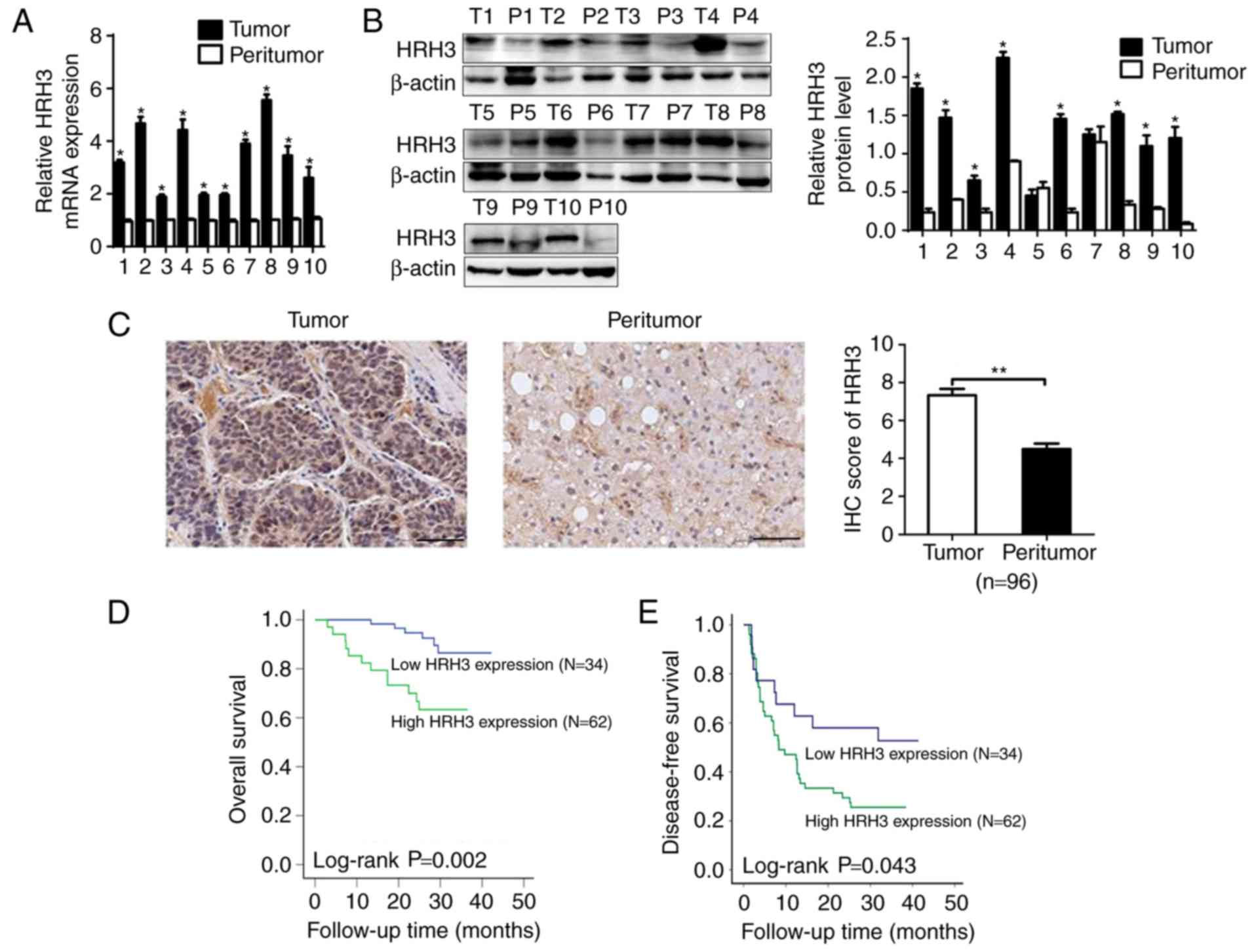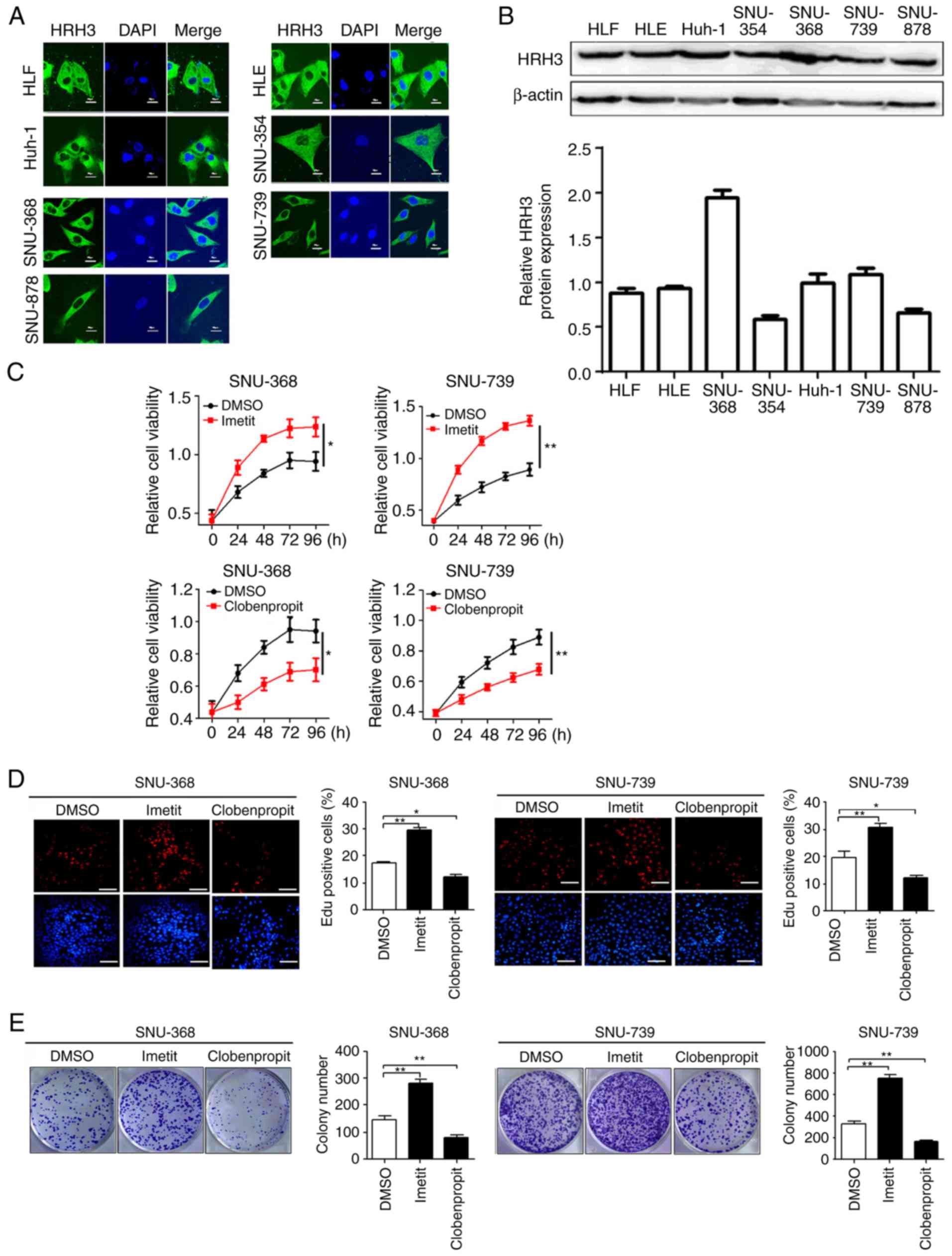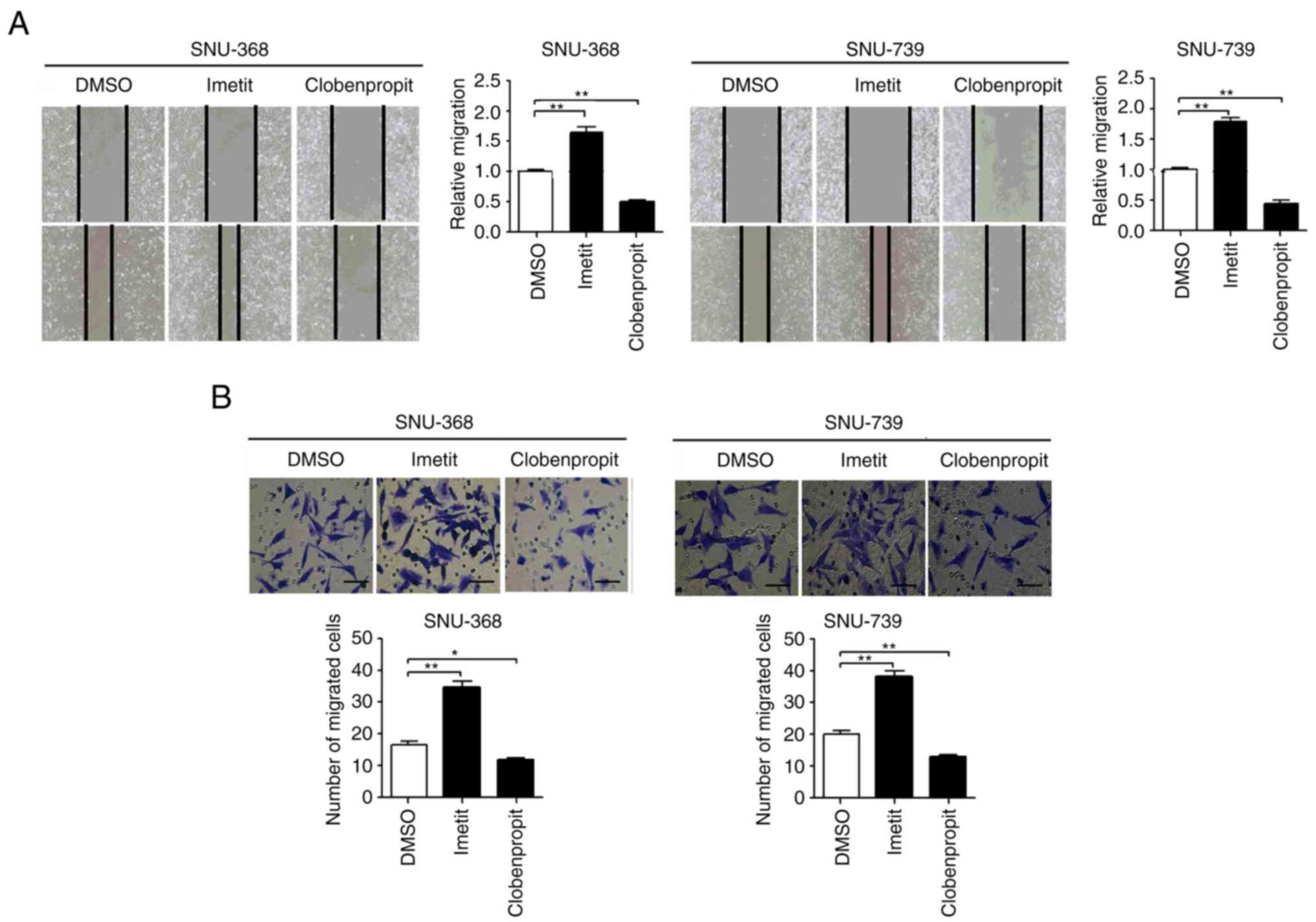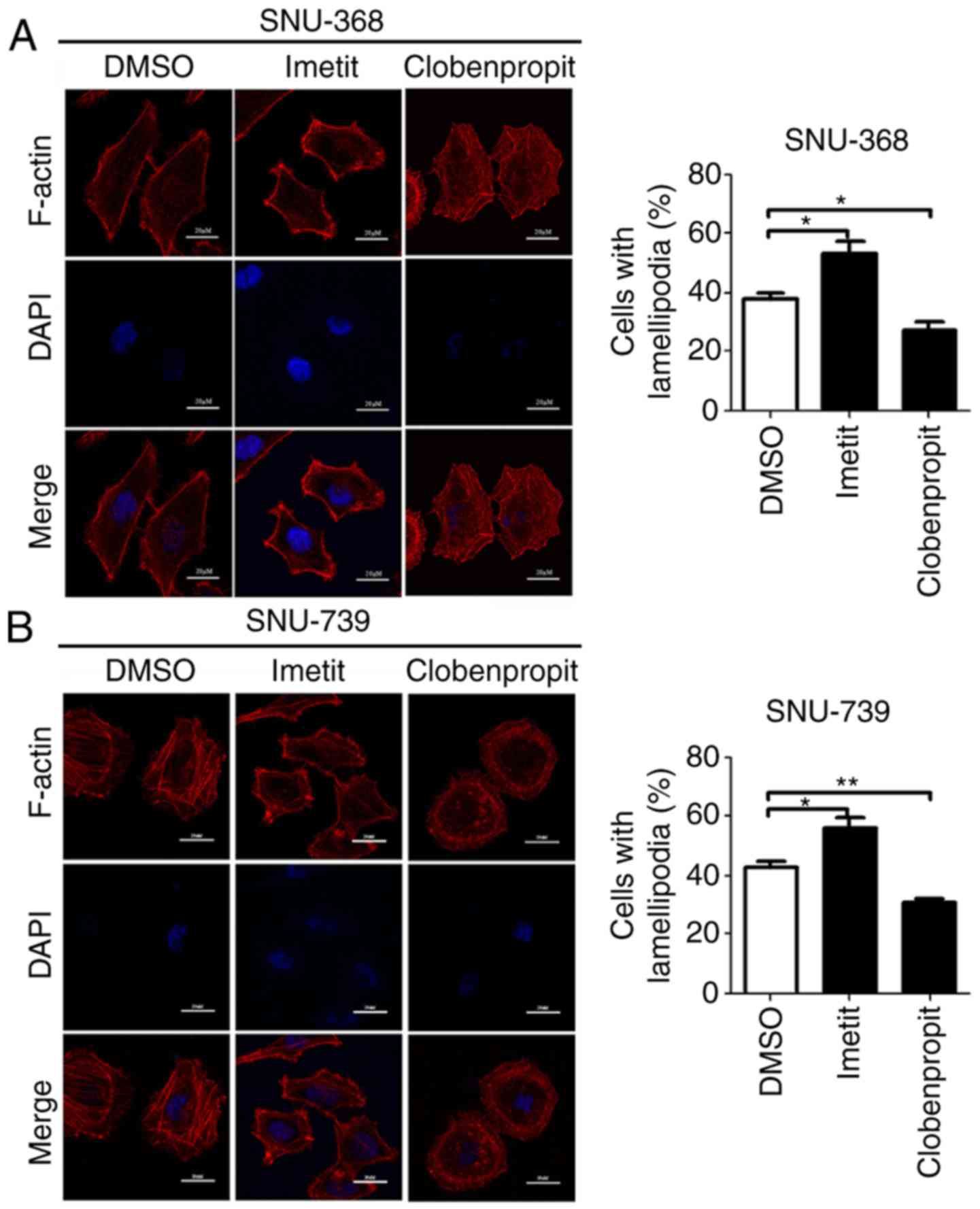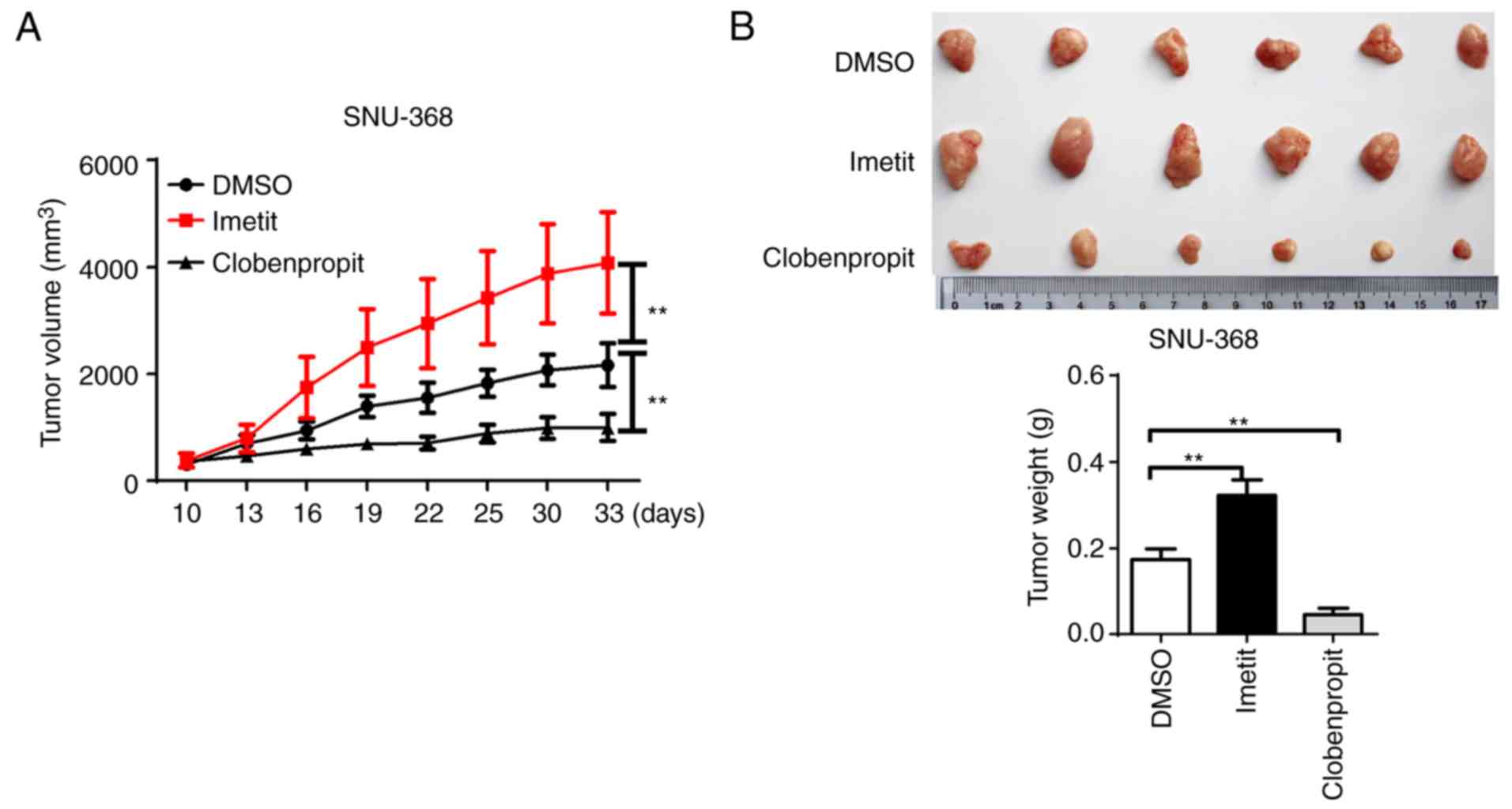Upregulated histamine receptor H3 promotes tumor growth and metastasis in hepatocellular carcinoma
- Authors:
- Published online on: April 16, 2019 https://doi.org/10.3892/or.2019.7119
- Pages: 3347-3354
Abstract
Introduction
Histamine is a biogenic amine that is released throughout the entire body of an organism via the autocrine and/or paracrine mechanisms (1–3). The multiple actions of histamine are mediated by its receptors, including H1, H2, H3 and H4, which belong to the family of G protein-coupled receptors (4,5). Histamine receptor H3 (HRH3) is an integral membrane protein that regulates neurotransmitter release (6). In addition, HRH3 increases the voltage-dependent calcium currents in smooth muscles, and innervates the heart and blood vessels in the cardiovascular system (1). In multiple sclerosis patients, it was observed that HRH3 was highly expressed in oligodendroglial cells obtained from demyelination lesions, indicating the existence of a genetic association between susceptibility to multiple sclerosis and an exonic single nucleotide polymorphism in HRH3 (7). Decrease in HRH3 function was linked to epileptic activity in the temporal neocortex and hippocampus of patients with pharmacoresistant mesial temporal lobe epilepsy (8). It has also been reported that histamine and histamine receptors (HRs) are critical molecules during carcinogenesis and inflammation (9). Clobenpropit, an HRH3 antagonist, was observed to significantly lower the multiplicity of colonic adenocarcinoma, suggesting that HRH3 may be a possible oncoprotein and potential target in tumor therapies (10). Hepatocellular carcinoma (HCC) is one of the most common malignant tumors, and its incidence rate ranks the second among malignant tumors and >200,000 people succumb to HCC every year in China (11). However, the functional roles of HRH3 in tumor growth and metastasis remain largely unknown, particularly in HCC.
The full-length HRH3 protein is composed of 445 amino acids (1). Thus far, at least 20 isoforms of the human HRH3 have been identified based on the various splicing mRNA forms; however, their regional expression and function currently remain unclear (1). The stimulation of HRH3 negatively regulates the synthesis of histamine via inhibiting adenylate cyclase, which then catalyzes the formation of the second messenger cyclic adenosine monophosphate, followed by the activation of histidine decarboxylase (1). Thus, the activation of HRH3 leads to a decrease in histamine synthesis in neurons. However, the activation of the HRH3 signaling pathway has been poorly elaborated in cancer cells, particularly in HCC cells.
In the present study, the expression and functional roles of HRH3 in HCC were systematically investigated. The study results improve the understanding on the pathological roles of HRH3 and provide experimental evidence for the application of HRH3 as a potential therapeutic target in HCC.
Materials and methods
Reagents and antibodies
The HRH3 antagonist clobenpropit and agonist imetit were purchased from Abcam (Cambridge, UK). The primary antibodies used in western blot analysis and their working concentrations were as follows: HRH3 (dilution 1:1,000; cat. no. ab236952; Abcam) and β-actin (dilution 1:3,000; cat. no. 20536-1-AP; ProteinTech Group, Inc., Chicago, IL, USA). In immunohistochemical (IHC) analysis, the HRH3 antibody was used at a dilution of 1:200. In immunofluorescence analysis, the HRH3 (dilution 1:200) and F-actin (dilution 1:300; cat. no. ab205; Abcam) antibodies were used.
Cell culture and tissue collection
The HLF, JHH-2, Huh-1 and HLE cell lines were from Japanese Collection of Research Biosources Cell Bank (JCRB), and were cultured in Dulbecco's modified Eagle's medium (Gibco; Thermo Fisher Scientific, Inc., Waltham, MA, USA), supplemented with 10% fetal bovine serum (FBS; HyClone; GE Healthcare Life Sciences, Logan, UT, USA). SNU739, SNU368, SNU354 and SNU878 cell lines were from the Korean Cell Line Bank (KCLB), and were routinely cultured in RPMI-1640 medium (Gibco; Thermo Fisher Scientific, Inc.) supplemented with 10% FBS (HyClone; GE Healthcare Life Sciences).
Between January 2009 and January 2012, a total of 96 Han Chinese patients with primary HCC were recruited from Xijing Hospital of the Fourth Military Medical University (Xi'an, China). There was no previous history of other cancers for all patients. All patients received surgery within 2 months after diagnosis and no patient received anticancer treatment before surgery. All tissue samples were stored in liquid nitrogen. The present study was approved by the Ethics Committee of the Fourth Military Medical University (Xi'an, China) and written informed consent was obtained from all the patients involved in the study.
Reverse transcription-quantitative polymerase chain reaction (RT-qPCR)
Total RNA was extracted from tissue samples or cultured cells using TRIzol reagent (Invitrogen; Thermo Fisher Scientific, Inc.). RNA concentration was measured by spectrophotometer (One Drop Nanjing, China) and was adjusted to 50 ng/µl with ddH2O. RT was performed using the PrimeScript RT reagent kit (Takara Bio, Inc., Ostu, Japan) according to the manufacturer's protocol. Next, qPCR was performed using the SYBR 2X qPCR Master Mix (Takara Bio, Inc.) in order to determine HRH3 expression, with GAPDH serving as the internal control. The cycling parameters were as follows: 95°C for 15 sec, 55°C for 15 sec and 72°C for 15 sec for 40 cycles. All primer sequences used in qPCR are listed in Table I. The relative expression of target genes was determined using the 2−ΔΔCq method (12).
Western blot analysis
Cells or tissues were lysed in cold RIPA buffer and protein concentrations were determined using a BCA protein assay kit (Beyotime Institute of Biotechnology, Haimen, China). A total of 50 µG protein was separated by 10% sodium dodecyl sulfate-polyacrylamide gel electrophoresis, and then proteins were transferred to polyvinylidene difluoride (PVDF) membranes, which was blocked by soaking in 5% non-fat milk for 1 h at room temperature. The membranes were incubated with specific primary antibodies against HRH3 and β-actin overnight at 4°C, and then with horseradish peroxidase-conjugated secondary antibody (dilution 1:10,000; cat. no. SA00001-2; ProteinTech Group, Inc.) at room temperature for 2 h. Finally, the protein bands were visualized using an enhanced chemiluminescence detection system (Clinx Science Instruments Co., Ltd., Shanghai, China). ImageJ software (NIH; National Institutes of Health, Bethesda, MD, USA) was used to quantify the protein band intensity.
IHC analysis
HCC tissues were fixed in 4% paraformaldehyde and embedded in paraffin. IHC analysis was then performed on 4-µm paraffin-embedded sections using an IHC kit (Invitrogen; Thermo Fisher Scientific, Inc.). The expression level of target proteins was blindly evaluated by two pathologists according to the proportion and intensity of positive cells within five microscopic visual fields/slide, as previously described (13). The final score between 0–3 was determined as low expression and a score >3 was determined as high expression.
Immunofluorescence analysis
HCC cells were washed with PBS and fixed with 4% paraformaldehyde for 15 min. Cells were then permeabilized with 0.2% Triton X-100 in PBS followed by blocking in blocking buffer (2% BSA in PBS) for 30 min. Cells were incubated overnight at 4°C with HRH3 antibody at 1:200 dilution or F-actin antibody at 1:300 dilution followed by immunofluorescence-goat anti-rabbit IgG H&L (FITC) (dilution 1:100; cat. no. ab6717; Abcam). The nuclear counterstain is DAPI (dilution 1:5,000; cat. no. C1002; Beyotime Institute of Biotechnology).
Cell viability assay
SNU-739 and SNU-368 cells were seeded into 96-well plates at a density of 1,000 cells/well and incubated for 100 µM imetit, or 100 µM clobenpropit, or dimethyl sulfoxide (DMSO) for 24 h, and the cell viability was measured by an MTS assay (Beyotime Institute of Biotechnology) according to the manufacturer's protocol. The microplates were read in a spectrophotometer at 490 nm.
Colony formation assay
SNU-739 and SNU-368 cells (1×103/well) were seeded into 6-well plates and cultured for two weeks. Subsequent to staining with 1% crystal violet, the number of colonies formed was counted.
Wound healing assay
SNU-739 and SNU-368 cell migration was measured by a wound healing assay. Briefly, ~105 cells were seeded into a 6-well plate and incubated until they reached 80% confluence. Next, a scratch wound was made in each well using a pipette tip, and this time-point was marked as 0 h. Images of the cells were captured at 0 and 48 h in order to assess the migration ability.
Transwell migration assay
For Transwell migration assays, Transwell insert (Becton Dickinson Biosciences, San Jose, USA) were placed into the wells of 24-well culture plates, SNU-739 and SNU-368 cells (~104) cultured in medium with 1% FBS was added to the upper chamber. In the lower chamber of the Transwell insert, medium with 10% FBS was added. Following incubation for 48 h, cells that had migrated to the lower surface of the filter were stained with 1% crystal violet, and then the non-migrated cells remaining on the upper membrane were removed with a cotton wool. Migration was determined by counting the number of cells in five random microscopic fields/well.
In vivo assays for tumor growth
A total of 18 BALB/c male nude mice (5 weeks old; body weight, 18–22 g) were purchased the from Animal Center of the Fourth Military Medical University (Xi'an, China), and were housed under a 12-h light/dark cycles at 20–22 with 60% humidity and had free access to food and water. The mice were randomly divided into three groups (n=6/group). Mice were subjected to a subcutaneous injection of 1×107 SNU-368 cells into their back in order to contract xenografts. After one week, imetit (40 µg/kg/mouse in 100 µl DMSO) or clobenpropit (20 µg/kg/mouse in 100 µl DMSO) or DMSO (100 µl/mouse) was administered by tail vein injection every three days for one month. The tumor volume (mm3) was measured every three days, as previously described (14). After one month of treatment, the mice were sacrificed by injection of an overdose of pentobarbital sodium, the tumor nodules were harvested, and images of tumor tissues were captured. All animal experimental procedures were approved by the Ethics Committee of the Fourth Military Medical University.
Statistical analysis
Experiments were repeated three times, where appropriate. Data are represented as the mean ± standard error of the mean. SPSS software (version 17.0; SPSS, Inc., Chicago, IL, USA) was used to conduct statistical analyses, and P<0.05 was considered to denote a statistically significant difference. Paired or unpaired t-tests were used for comparisons between two groups, while one-way analysis of variance (ANOVA) was used for comparisons among three or more groups. Overall survival (OS) and recurrence-free survival (RFS) in relation to HFH3 expression were evaluated by the Kaplan-Meier survival curve and the log-rank test.
Results
HRH3 is upregulated in HCC tissues and contributes to tumor progression and worse prognosis
The mRNA and protein expression levels of HRH3 were first evaluated in 10 paired tumor and peritumor tissues from HCC patients. RT-qPCR and western blot analysis data demonstrated that HRH3 was significantly upregulated in HCC tissues when compared with peritumor tissues (Fig. 1A and B). The expression of HRH3 was then further evaluated by IHC analysis in 96 paired tumor and peritumor tissues from HCC patients. As shown in Fig. 1C, HRH3 was significantly upregulated in HCC tissues when compared with the paired peritumor tissues.
The prognostic significance of HRH3 was also assessed in the 96 HCC patients based on the IHC data from the tumor tissues. Kaplan-Meier survival analysis revealed that HCC patients with high HRH3 expression had significantly shorter OS and RFS as compared with those in patients exhibiting low HRH3 expression (Fig. 1D and E). Taken together, these data indicated that HRH3 contributes to the progression and poor prognosis of HCC.
HRH3 promotes HCC cell growth in vitro
To explore the potential function of HRH3 in cell growth, a series of in vitro biological experiments were performed using an agonist (imetit) or antagonist (clobenpropit) of HRH3. Immunofluorescence and western blot data demonstrated that the expression of HRH3 in SNU-368 and SNU-739 cells was relatively high among the seven HCC cell lines examined (Fig. 2A and B). Next, the MTS assay revealed that HCC cells treated with HRH3 agonist (imetit) exhibited a significantly faster growth compared with the control (DMSO-treated) cells, whereas HCC cells treated with HRH3 antagonist (clobenpropit) exhibited significantly slower growth than the control cells (Fig. 2C). Consistent with this, the number of colonies and 5-ethynyl-2′-deoxyuridine (EdU)-positive cells were significantly increased in HCC cells after treatment with imetit, whereas these were significantly decreased in HCC cells following treatment with clobenpropit, when compared with the respective control group (Fig. 2D and E).
HRH3 promotes the migration of HCC cells in vitro
The effects of HRH3 on the migration of HCC cells were also investigated using scratch wound healing and Transwell assays. The scratch wound healing assay revealed that the migration ability of HCC cells was markedly increased when HRH3 was activated by imetit. By contrast, the migration capability of HCC cells was significantly decreased following treatment with clobenpropit (Fig. 3A). Similarly, the Transwell migration assay also indicated that activation of HRH3 by imetit significantly enhanced the migration ability of HCC cells, while inhibition of HRH3 by clobenpropit had the opposite effect (Fig. 3B). These results indicated that HRH3 increased the migration abilities of HCC cells.
HRH3 promotes the migration of HCC by inducing lamellipodium formation
Lamellipodia are flattened extensions of the cell that serve a key role in cell migration. To explore the mechanisms by which HRH3 promotes HCC cell migration, lamellipodium formation was evaluated in SNU-368 and SNU-739 cells following treatment with imetit or clobenpropit. F-actin staining results demonstrated that stimulation of HRH3 through binding of the agonist imetit markedly increased lamellipodium formation in HCC cells. By contrast, inhibition of HRH3 through binding of the antagonist clobenpropit significantly decreased lamellipodium formation in HCC (Fig. 4). These results suggested that HRH3 promoted the migration of HCC cells mainly through regulating actin rearrangement.
HRH3 promotes HCC cell growth in vivo
To further investigate the tumorigenic effect of HRH3 in vivo, a xenograft model was constructed in nude mice using the SNU-368 cell line. As shown in Fig. 5A and B, a significant increase in the growth capacity (tumor volume and weight) was observed in xenograft tumors treated with imetit when compared with the control xenograft tumors. By contrast, clobenpropit treatment significantly inhibited the growth of xenograft tumors.
Discussion
Recently, high expression levels of HRs have been reported in different cancer types, including gastrointestinal cancer, melanoma, pancreatic and breast cancer (6,9). The results in the present study demonstrated that HRH3 was significantly upregulated in HCC tissues and contributed to tumor progression, suggesting that increased HRH3 level may serve as a potential prognostic marker for HCC patients. Consistent with these results, a previous study in breast cancer reported that the expression of HRH3 was significantly higher in carcinoma tissues compared with that in benign lesions and non-tumor breast tissues (15). Similarly, HRH3 expression was significantly higher in adrenocortical cancer samples in comparison with that in normal adrenal cortex and benign adrenocortical adenomas (16). Another study reported that HRH3 was upregulated in glioblastoma and glioma cell lines when compared with normal brain tissue and astrocytes, while overexpression of HRH3 was associated with glioma progression (17). However, He et al (18) reported that gene polymorphisms of HRH3 are irrelevant in breast cancer. Taken together, all these results indicate that HRH3 is upregulated in malignant carcinomas, suggesting that it may serve as a novel therapeutic target in a number of malignancies.
Previous functional studies have reported that HRH3 induces dual effects on tumor proliferation, and promotes cell proliferation and tumor growth in several types of cancer. For instance, Lin et al (17) have indicated that inhibition of HRH3 suppresses glioblastoma cell growth. Furthermore, it has been demonstrated that histamine increased MDA-MB-231 cell proliferation via HRH3, suggesting that HRH3 is involved in the regulation of breast cancer growth (19). In addition, the proliferation of breast cancer cells was markedly suppressed upon treatment with an HRH3 antagonist, such as OUP-186 and clobenpropit (19). A study by Cricco et al (20) indicated that HRH3 was involved in pancreatic carcinoma cell growth, and that the proliferation was increased through activating HRH3. By contrast, the stimulation of HRH3 through binding of an agonist inhibited the growth of cholangiocarcinoma in vitro and in vivo (21), while it also inhibited the biliary growth of BDL rats (22). In addition, the results of Davenas et al (23) demonstrated that HRH3 antagonists increased McA-RH7777 hepatoma cell proliferation, suggesting that HRH3 may negatively regulate McA-RH7777 cell growth. Consistent with previous studies (17,19,20), the results reported in the present study indicated that stimulation of HRH3 by imetit significantly increased the proliferation ability of HCC cells, whereas inhibition of HRH3 by clobenpropit markedly suppressed HCC cell proliferation, which indicated that overexpression of HRH3 promoted HCC progression. The dual roles of HRH3 in cancer cell growth may be cell-type specific, however, this warrants more comprehensive investigation.
Previous experiments have proven that HRH3 serves an important role in promoting tumor invasion and metastasis. For example, the decrease in cholangiocarcinoma invasion was proven to be mediated by the activation of HRH3 (21). In addition, the study of Lin et al (17) demonstrated that inhibition of HRH3 suppressed glioblastoma tumor invasion. Furthermore, the histamine-HRH3 axis signaling prompted MDA-MB-231 cell migration, suggesting that HRH3 may be involved in the regulation of breast cancer progression (19). Consistent with these previous studies, the present study demonstrated that activation of HRH3 promoted HCC cell migration, while the inhibition of HRH3 suppressed the metastasis of HCC cells, which further supports the functional roles of HRH3 in promoting the metastasis of malignant carcinomas.
Thus far, the mechanisms by which HRH3 promotes malignant carcinoma growth and metastasis remain undefined. Francis et al (21) demonstrated that HRH3 inhibited cholangiocarcinoma growth by PKCα-dependent ERK1/2 dephosphorylation. In addition, HRH3 has been proven to increase proliferation through regulation of the cell cycle in normal and tumor epithelial tissues (24–26). The results of Lin et al (17) also indicated that inhibition of HRH3 led to suppressed invasion and epithelial-mesenchymal transition of glioblastoma by inactivating the PI3K/Akt and MEK/ERK pathways. The lamellipodium is a dynamic surface extension of the cell, which serves a pivotal role in cell migration (27). The present study demonstrated that activation of HRH3 promoted HCC cell migration with increased formation of lamellipodia, whereas inhibition of HRH3 suppressed the migration of HCC cells, with decreased formation of lamellipodia. Furthermore, phosphorylation of paxillin has been demonstrated to be involved in the progression and metastasis of different malignancies (28,29). A previous study from our group has also reported that phosphorylation of paxillin was involved in the formation of lamellipodia in HCC cells (30). Considering that mounting evidences have indicated that PKC and PKA are commonly triggered by the activation of HRs, it can be speculated that HRH3 induces the formation of lamellipodia mainly by activating PKC or PKA, although this requires further investigation.
In conclusion, the present study revealed that HRH3 was upregulated in HCC tissues and was closely correlated with poor prognosis in HCC patients. Furthermore, upregulation of HRH3 facilitated HCC cell growth and metastasis. In our future study, small interference RNA-based experiments will be applied to provide further support for the findings of the present study. Taken together, the results of the present study suggest that HRH3 may be used as a novel therapeutic target in HCC.
Acknowledgements
Not applicable.
Funding
The present study was supported by the National Natural Science Foundation of China (grant nos. 81472298 and 81502085).
Availability of data and materials
The datasets used and analyzed during the current study are available from the corresponding author upon reasonable request.
Authors' contributions
DY performed most experiments and wrote the manuscript. YW and QZ participated in the cell proliferation and metastasis analyses. JZhao participated in the in vivo experiments and immunofluorescence assay. JH performed data analysis. JL was involved in the conception of the study. JZhu designed the overall study, analyzed the results and also wrote the manuscript. All authors read and approved the manuscript and agree to be accountable for all aspects of the research in ensuring that the accuracy or integrity of any part of the work are appropriately investigated and resolved.
Ethics approval and consent to participate
All human and animal experiments conducted in the present study were approved by the Ethics Committee of the Fourth Military Medical University (Xi'an, China). Written informed consent was obtained from all patients involved in the study.
Patient consent for publication
Not applicable.
Competing interests
The authors declare that they have no competing interests.
References
|
Singh M and Jadhav HR: Histamine H3 receptor function and ligands: Recent developments. Mini Rev Med Chem. 13:47–57. 2013. View Article : Google Scholar : PubMed/NCBI | |
|
Coruzzi G, Adami M and Pozzoli C: Role of histamine H4 receptors in the gastrointestinal tract. Front Biosci. 4:226–239. 2012. View Article : Google Scholar | |
|
Hegyesi H, Darvas Z, László V, Pós Z, Pállinger E, Hirschberg K, Kovács P and Falus A: Retinoic acid enhances histamine content and H1 receptor expression in human neuroblastoma cell line Paju. Anticancer Res. 24:1657–1663. 2004.PubMed/NCBI | |
|
Kitakaze M: Clinical evidence of the role of histamine in heart failure. J Am Coll Cardiol. 67:1553–1555. 2016. View Article : Google Scholar : PubMed/NCBI | |
|
de Esch IJ, Thurmond RL, Jongejan A and Leurs R: The histamine H 4 receptor as a new therapeutic target for inflammation. Trends Pharmacol Sci. 26:462–469. 2005.PubMed/NCBI | |
|
Medina VA and Rivera ES: Histamine receptors and cancer pharmacology. Brit J Pharmacol. 161:755–767. 2010. View Article : Google Scholar | |
|
Chen Y, Zhen W, Guo T, Zhao Y, Liu A, Rubio JP, Krull D, Richardson JC, Lu H and Wang R: Histamine receptor 3 negatively regulates oligodendrocyte differentiation and remyelination. PLoS One. 12:e1893802017. View Article : Google Scholar | |
|
Bhowmik M, Khanam R and Vohora D: Histamine H3 receptor antagonists in relation to epilepsy and neurodegeneration: A systemic consideration of recent progress and perspectives. Brit J Pharmacol. 167:1398–1414. 2012. View Article : Google Scholar | |
|
Yang XD, Ai W, Asfaha S, Bhagat G, Friedman RA, Jin G, Park H, Shykind B, Diacovo TG, Falus A and Wang TC: Histamine deficiency promotes inflammation-associated carcinogenesis through reduced myeloid maturation and accumulation of CD11b+Ly6G+ immature myeloid cells. Nat Med. 17:87–95. 2011. View Article : Google Scholar : PubMed/NCBI | |
|
Tanaka T, Kochi T, Shirakami Y, Mori T, Kurata A, Watanabe N, Moriwaki H and Shimizu M: Cimetidine and clobenpropit attenuate inflammation-associated colorectal carcinogenesis in male ICR mice. Cancers. 8(pii): E252016. View Article : Google Scholar : PubMed/NCBI | |
|
Wong MC, Jiang JY, Goggins WB, Liang M, Fang Y, Fung FD, Leung C, Wang HH, Wong GL, Wong VW, et al: International incidence and mortality trends of liver cancer: A global profile. Sci Rep. 7:458462017. View Article : Google Scholar : PubMed/NCBI | |
|
Livak KJ and Schmittgen TD: Analysis of relative gene expression data using real-time quantitative PCR and the 2−ΔΔCT method. Methods. 25:402–408. 2001. View Article : Google Scholar : PubMed/NCBI | |
|
Huang Q, Lei Z, Cao H, Li J, Lyu Y, Guo X, Zhang J, Ji L, Ren T, An J, et al: Increased mitochondrial fission promotes autophagy and hepatocellular carcinoma cell survival through the ROS-modulated coordinated regulation of the NFKB and TP53 pathways. Autophagy. 12:999–1014. 2016. View Article : Google Scholar : PubMed/NCBI | |
|
Zhu J, Jin M, Wang J, Zhang H, Wu Y, Li D, Ji X, Yang H, Yin C, Ren T, et al: TNFα induces Ca2+ influx to accelerate extrinsic apoptosis in hepatocellular carcinoma cells. J Exp Clin Canc Res. 37:432018. View Article : Google Scholar | |
|
Medina V, Croci M, Crescenti E, Mohamad N, Sanchez-Jiménez F, Massari N, Nuñez M, Cricco G, Martin G, Bergoc R, et al: The role of histamine in human mammary carcinogenesis: H3 and H4 receptors as potential therapeutic targets for breast cancer treatment. Cancer Biol Ther. 7:28–35. 2008. View Article : Google Scholar : PubMed/NCBI | |
|
Szabó PM, Wiener Z, Tömböl Z, Kovács A, Pócza P, Horányi J, Kulka J, Riesz P, Tóth M, Patócs A, et al: Differences in the expression of histamine-related genes and proteins in normal human adrenal cortex and adrenocortical tumors. Virchows Arch. 455:133–142. 2009. View Article : Google Scholar : PubMed/NCBI | |
|
Lin JJ, Zhao TZ, Cai WK, Yang YX, Sun C, Zhang Z, Xu YQ, Chang T and Li ZY: Inhibition of histamine receptor 3 suppresses glioblastoma tumor growth, invasion, and epithelial-to-mesenchymal transition. Oncotarget. 6:17107–17120. 2015.PubMed/NCBI | |
|
He GH, Lin JJ, Cai WK, Xu WM, Yu ZP, Yin SJ, Zhao CH and Xu GL: Associations of polymorphisms in histidine decarboxylase, histamine N-methyltransferase and histamine receptor H3 genes with breast cancer. PLoS One. 9:e977282014. View Article : Google Scholar : PubMed/NCBI | |
|
Tanaka S, Sakaguchi M, Yoneyama H, Usami Y and Harusawa S: Histamine H3 receptor antagonist OUP-186 attenuates the proliferation of cultured human breast cancer cell lines. Biochem Biophys Res Commun. 480:479–485. 2016. View Article : Google Scholar : PubMed/NCBI | |
|
Cricco GP, Mohamad NA, Sambuco LA, Genre F, Croci M, Gutiérrez AS, Medina VA, Bergoc RM, Rivera ES and Martín GA: Histamine regulates pancreatic carcinoma cell growth through H3 and H4 receptors. Inflamm Res. 57 (Suppl 1):S23–S24. 2008. View Article : Google Scholar : PubMed/NCBI | |
|
Francis H, Onori P, Gaudio E, Franchitto A, DeMorrow S, Venter J, Kopriva S, Carpino G, Mancinelli R, White M, et al: H3 histamine receptor-mediated activation of protein kinase Calpha inhibits the growth of cholangiocarcinoma in vitro and in vivo. Mol Cancer Res. 7:1704–1713. 2009. View Article : Google Scholar : PubMed/NCBI | |
|
Francis H, Franchitto A, Ueno Y, Glaser S, DeMorrow S, Venter J, Gaudio E, Alvaro D, Fava G, Marzioni M, et al: H3 histamine receptor agonist inhibits biliary growth of BDL rats by downregulation of the cAMP-dependent PKA/ERK1/2/ELK-1 pathway. Lab Invest. 87:473–487. 2007. View Article : Google Scholar : PubMed/NCBI | |
|
Davenas E, Rouleau A, Morisset S and Arrang JM: Autoregulation of McA-RH7777 hepatoma cell proliferation by histamine H3 receptors. J Pharmacol Exp Ther. 326:406–413. 2008. View Article : Google Scholar : PubMed/NCBI | |
|
Kennedy L, Hodges K, Meng F, Alpini G and Francis H: Histamine and histamine receptor regulation of gastrointestinal cancers. Transl Gastrointest Cancer. 1:215–227. 2012.PubMed/NCBI | |
|
Grandi D, Schunack W and Morini G: Epithelial cell proliferation is promoted by the histamine H3 receptor agonist (R)-α-methylhistamine throughout the rat gastrointestinal tract. Eur J Pharmacol. 538:141–147. 2006. View Article : Google Scholar : PubMed/NCBI | |
|
Medina V, Cricco G, Nuñez M, Martín G, Mohamad N, Correa-Fiz F, Sanchez-Jimenez F, Bergoc R and Rivera ES: Histamine-mediated signaling processes in human malignant mammary cells. Cancer Biol Ther. 5:1462–1471. 2006. View Article : Google Scholar : PubMed/NCBI | |
|
Machesky LM: Lamellipodia and filopodia in metastasis and invasion. Febs Lett. 582:2102–2111. 2008. View Article : Google Scholar : PubMed/NCBI | |
|
Brown MC, Perrotta JA and Turner CE: Serine and threonine phosphorylation of the paxillin LIM domains regulates paxillin focal adhesion localization and cell adhesion to fibronectin. Mol Biol Cell. 9:1803–1816. 1998. View Article : Google Scholar : PubMed/NCBI | |
|
Huang C, Jacobson K and Schaller MD: A role for JNK-paxillin signaling in cell migration. Cell Cycle. 3:4–6. 2004. View Article : Google Scholar : PubMed/NCBI | |
|
Ren T, Zhang H, Wang J, Zhu J, Jin M, Wu Y, Guo X, Ji L, Huang Q, Zhang H, et al: MCU-dependent mitochondrial Ca2+ inhibits NAD+/SIRT3/SOD2 pathway to promote ROS production and metastasis of HCC cells. Oncogene. 36:5897–5909. 2017. View Article : Google Scholar : PubMed/NCBI |



